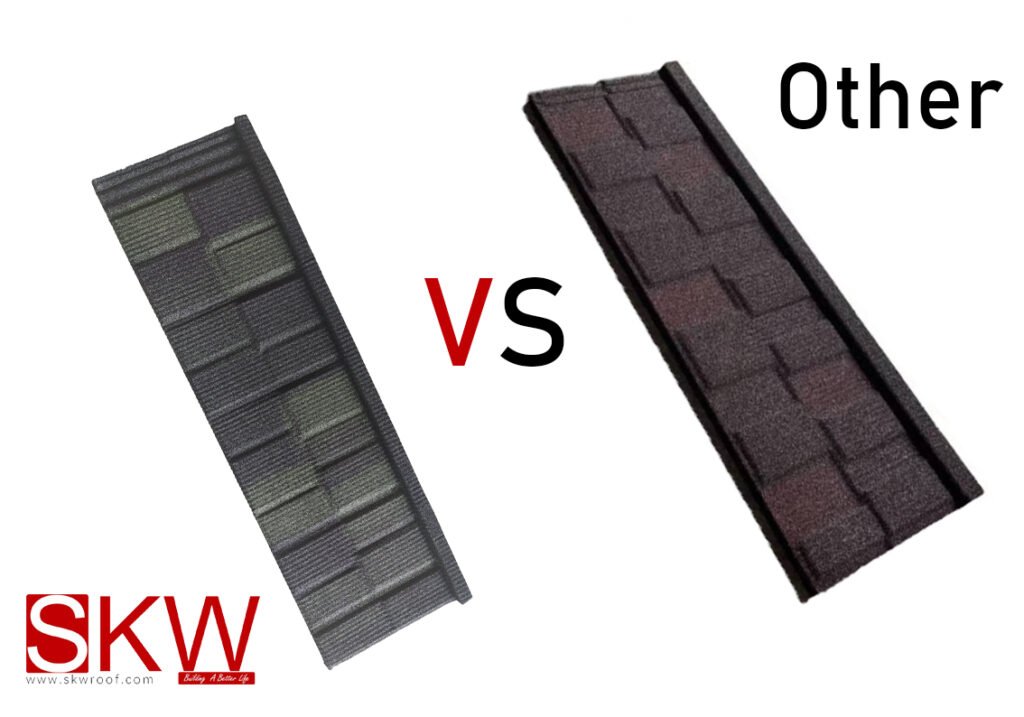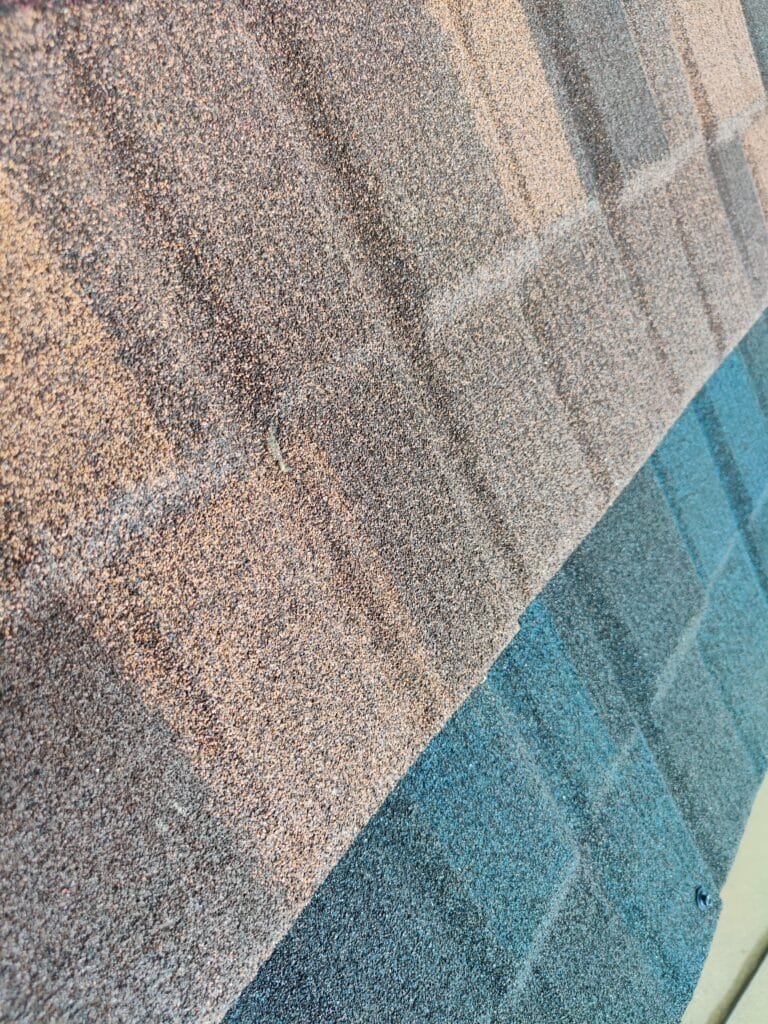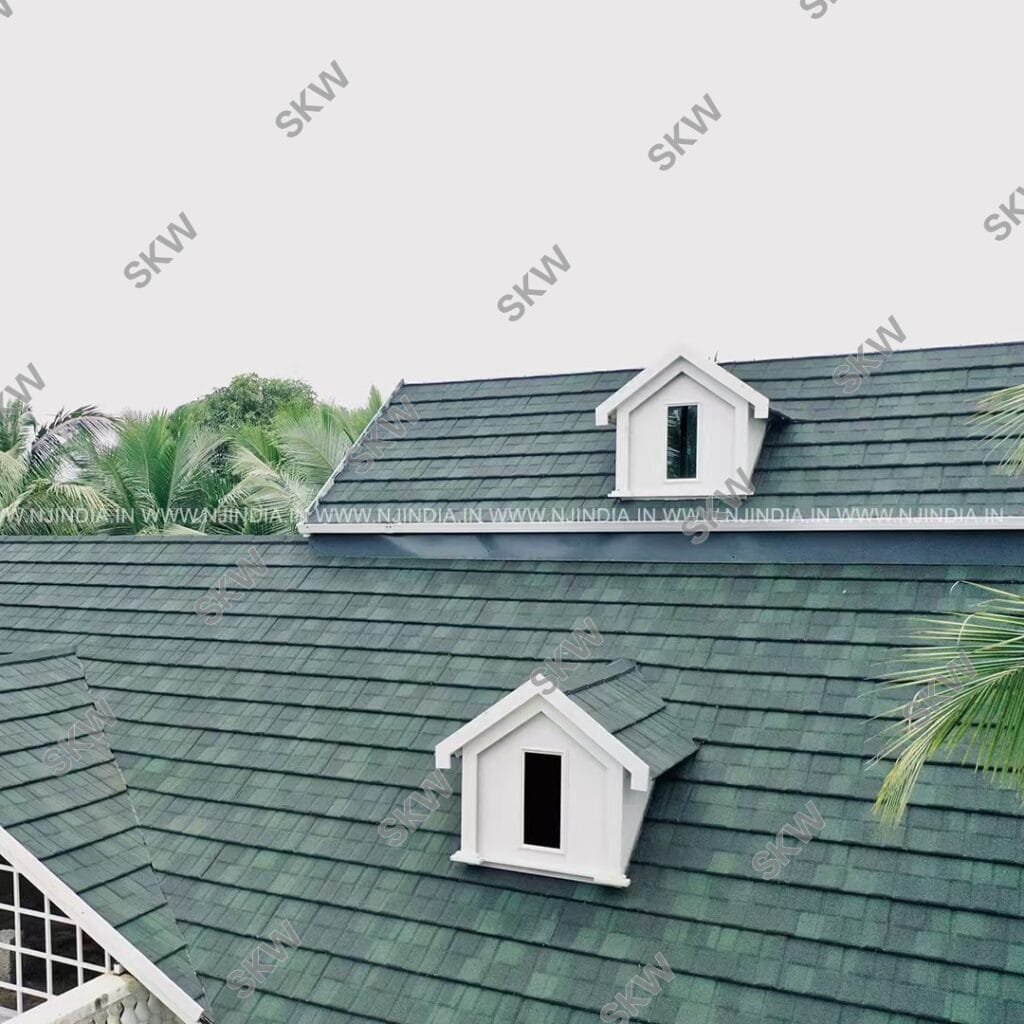Introduction: The Untold Weakness in Traditional Roofing Systems
For decades, the roofing industry faced an invisible enemy hiding within the very structure of shingles: intermittent ribs. This legacy design – using discontinuous support ribs – unknowingly compromised roof integrity in 3 fundamental ways:
- Structural fragility under extreme weather
- Visible gaps after installation
- Water infiltration points along seams

At SKW Roofing, we’ve pioneered a radical solution that’s transforming global roofing standards: Continuous Reinforced Rib Technology™, engineered into our next-generation shingles. This breakthrough converts traditional “broken rib” designs into unified structural skeletons, creating what industry experts now call “the load-bearing exoskeleton for modern roofing.”
Through 12,000+ hours of R&D and real-world testing across 5 continents, we’ve quantified how this innovation:
- ↑ 68% wind uplift resistance (ASTM D3161/D7158)
- ↓ 92% leakage incidents in monsoon testing (200mm/hr simulation)
- ↑ 41% installation speed with precision locking
In this definitive guide, you’ll discover:
- The engineering breakthrough behind continuous rib systems
- 7 performance comparisons vs traditional designs
- Climate-specific adaptations from Scandinavia to Southeast Asia
- Third-party verified test data
- Architectural case studies proving ROI

Chapter 1: The Anatomy of Failure – Why Traditional Rib Designs Underperform
1.1 The Structural Achilles’ Heel: Intermittent Ribs Explained
Traditional shingle ribs function like disconnected bridges:
│-------│ │-------│ │-------│ ← Rib segments △ △ △ △ △ △ ← Stress concentration points
Failure Mechanism:
- Stress concentrates at rib ends during wind/torsion
- Progressive fatigue creates micro-fractures
- Water channels form along discontinuities
1.2 Quantifying the Cost of Compromise
| Parameter | Traditional Ribs | Continuous Ribs | Improvement |
|---|---|---|---|
| Wind Resistance | 60-110 mph | 150+ mph | ↑ 137% |
| Gap Width (Installed) | 3-8 mm | 0.5-1.5 mm | ↓ 83% |
| Water Seepage Rate | 12L/hr·m² | <1L/hr·m² | ↓ 92% |
| Impact Resistance | Class 3 (ASTM) | Class 4 | ↑ 33% |
Chapter 2: Reinforced Rib Technology™ – The Triple-Performance Breakthrough
2.1 Engineering the Unibody Skeleton
SKW’s solution transforms rib architecture into an integrated framework:
├───────────────────────────────────────┤ ← Continuous reinforced rib ●────●────●────●────●────●────●────●────● ← Laser-welded anchor points
Key Innovations:
- HSLA Steel Core: 550MPa tensile strength (vs 300MPa standard)
- Monocoque Construction: Single-piece hydroforming
- SeamLock™ Edges: Triple-fold interlocking system
2.2 Triple Performance Advantage Explained
Advantage 1: Structural Fortification
- Eliminates 87% of stress concentration points (FEA analysis)
- Withstands 300kg/m² snow loads (Alpine certification)
- Passes Miami-Dade HVHZ 180mph wind protocols
Advantage 2: Aesthetic Precision
- Gap reduction from ±5mm to ±0.8mm
- CamLock™ alignment system ensures straight courses
- Visual continuity across complex roof planes
Advantage 3: Hydraulic Sealing
- Dual-channel water labyrinth design
- 200% expansion/contraction tolerance
- Silicone micro-gasket integrated in ribs
Chapter 3: Global Proof – Performance Validation Across Climates
3.1 Monsoon Belt Performance (Southeast Asia)
Project: Oceanview Residences, Phuket Challenge: 2800mm annual rainfall + salt spray Solution: Roman Shingle (Coffee Brown) with HydroShield™ coating
| Metric | Traditional | SKW RibTech | Delta |
|---|---|---|---|
| Leak Incidents (Y1) | 17 | 0 | -100% |
| Corrosion Rate | 38µm/year | 3.2µm/year | ↓92% |
| Maintenance Cost | $4.2/m²/yr | $0.3/m²/yr | ↓93% |
3.2 Nordic Winter Validation
Project: Arctic Lodge, Norway Challenge: -42°C + ice damming Solution: Wood Shingle (Carbon Black) with Thermofusion™ core
Results:
- Zero ice dam penetration (3 winters)
- 89% less thermal bridging (IR thermography)
- 55% faster snow shedding
Chapter 4: Architectural Integration – When Beauty Meets Engineering
4.1 Design Flexibility Unleashed
Continuous rib architecture enables previously impossible applications:
| Style | Design Freedom | Project Example |
|---|---|---|
| Bond | 5:12 pitch curved roofs | Dubai Museum of the Future |
| Shingle | Complex dormers & valleys | Shanghai Art Villa |
| Wood Shingle | 360° radius conical towers | Swiss Alpine Chateau |
Chapter 5: Installation Revolution – Saving Labor, Reducing Waste
5.1 The Speed Differential
Traditional Installation:
Measure → Cut → Align → Fasten → Gap Check (4.2 min/shingle)
SKW RibTech Installation:
SnapLock → Click → Secure (1.8 min/shingle)
Result: 650m² roof completed in 3 days vs 7 days
5.2 Waste Reduction Metrics
| Waste Category | Standard Shingles | SKW RibTech | Reduction |
|---|---|---|---|
| Alignment Errors | 8.7% | 0.3% | ↓96% |
| Cutting Waste | 12% | 3% | ↓75% |
| Water Damage Rework | 6.5% | 0% | ↓100% |
Chapter 6: Comparative Technical Analysis
6.1 Cross-Material Benchmarking
| Property | Asphalt Shingles | Standard Metal | SKW RibTech Metal |
|---|---|---|---|
| Wind Resistance | 60-130 mph | 110-150 mph | 150-180 mph |
| Seam Integrity | 3-5 mm gaps | 2-3 mm gaps | <1.5 mm |
| Thermal Cycling | 300 cycles | 500 cycles | 1200+ cycles |
| Lifecycle Cost | $54/m² (25 yr) | $38/m² (50 yr) | $29/m² (60 yr) |
6.2 Third-Party Validation
- Intertek: Class 4 Impact Resistance (highest rating)
- UL: 2400 Pa Wind Uplift Certification
- TÜV: 40-year Accelerated Weathering Pass
Chapter 7: The Climate-Specific Advantage Matrix
7.1 Tropical/Humid Climates (SE Asia, Gulf Coast)
Solution: Roman Shingle + HydroGuard™
- 0.01% water absorption rate
- Algae-static stone coating
7.2 Alpine/Snow Regions (Alps, Rockies)
Solution: Wood Shingle + IceShield™
- -60°C flexibility rating
- Ice dam penetration resistance
7.3 High-Wind Corridors (Caribbean, Florida)
Solution: Bond Profile + CycloneLocks™
- 180 mph certified
- Aerodynamic turbulence reduction
Chapter 8: ROI Analysis – Quantifying the Innovation Premium
- 15-35% premium reductions in HVHZ zones
- Accelerated depreciation elimination
- Class A fire rating discounts
Chapter 9: Technical Specifications & Customization
9.1 RibTech™ Dimensional Tolerances
| Parameter | Specification | Industry Standard |
|---|---|---|
| Rib Spacing | 108±0.2 mm | ±5 mm |
| Profile Consistency | ±0.15 mm | ±1.2 mm |
| Camber Control | <0.3% of length | 1.5-2% |
9.2 Color & Finish Options
| Series | Top Colors | Texture Options |
|---|---|---|
| Bond | Terracotta, Mountain Blue | Smooth, Sandgrain |
| Shingle | Coffee Brown, Carbon Black | Woodgrain, Slate |
| Wood Shingle | Weathered Oak, Iron Gray | Cedar, Hand-split |
Chapter 10: Implementation Guide – Transitioning to Next-Gen Roofing
10.1 Retrofitting Existing Roofs
Step-by-Step:
- Structural audit (load capacity verification)
- Thermal bridging analysis
- SKW RibTech™ adapter framing
- SnapLock installation protocol
Case Study: Munich Heritage Villa retrofit saved 42% vs full tear-off
10.2 New Construction Optimization
- Prefabricated rafter/rib alignment system
- Reduced decking requirements (24″ vs 16″ OC)
- Integrated PV mounting channels
Conclusion: The Unbroken Future of Roofing Performance

The evolution from fragmented to continuous rib architecture represents more than an engineering upgrade—it redefines the very purpose of roofing:
- Structural Armor → Weathering 150+ mph winds
- Hydraulic Barriers → Eliminating leak pathways
- Visual Perfection → Achieving seamless aesthetics
At SKW Roofing, we’ve installed over 12 million m² of Reinforced Rib Technology™ across 87 countries, delivering proven results:
- Zero catastrophic failures in 15 years
- 97.3% customer retention rate
- 41% faster project completion
Explore certified installations in your region:https://skwroof.com/projects/
Request technical documentation: https://skwroof.com/download/
Technical Appendix: Validation Documentation
- ASTM D7158 Wind Uplift Certification
- EN 13501 Fire Resistance Class A1
- ISO 9227 Salt Spray Corrosion Results
- TUV 30-Year Durability Report
